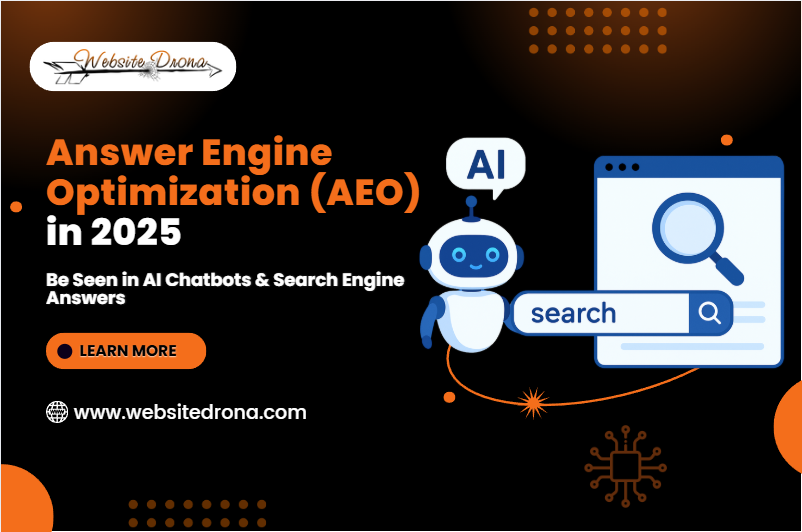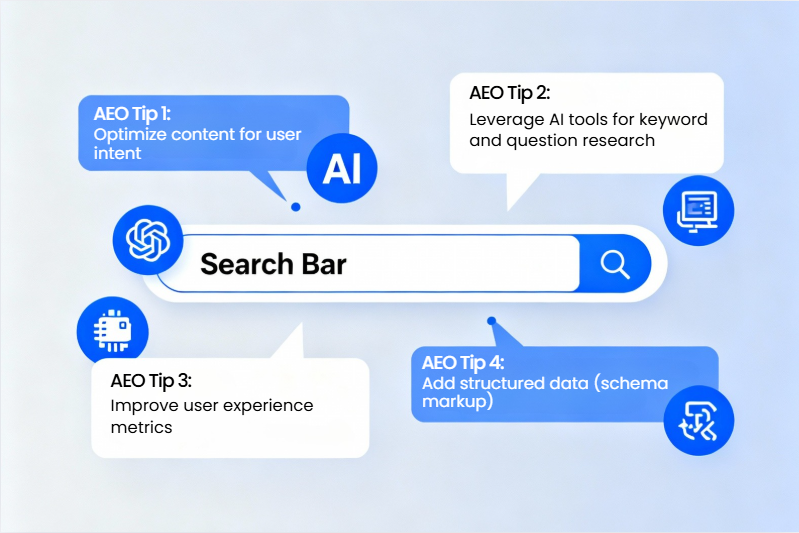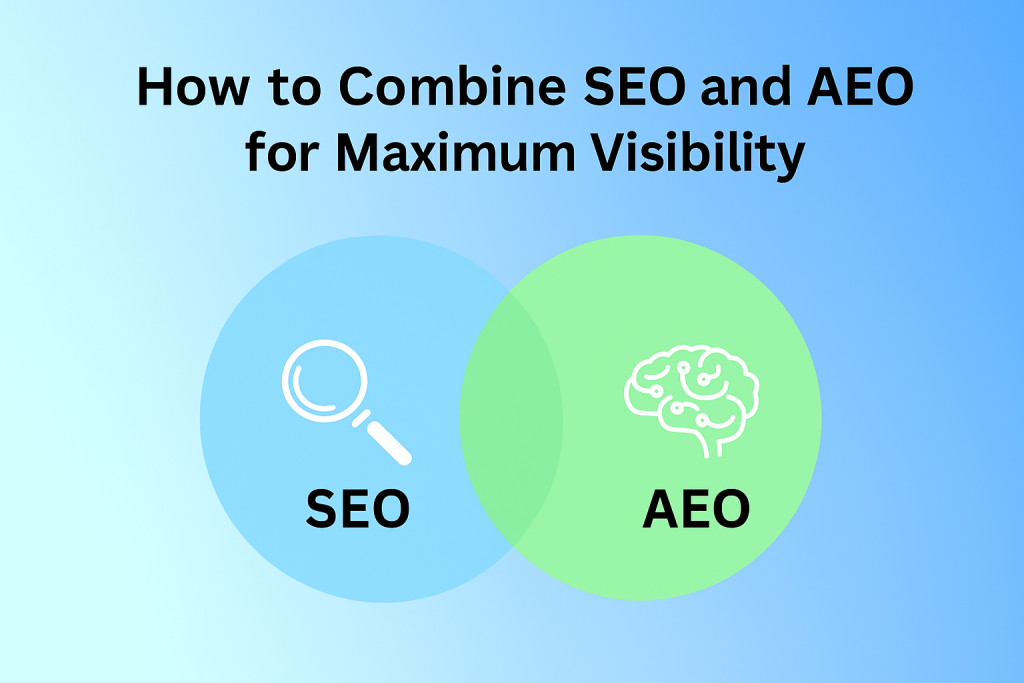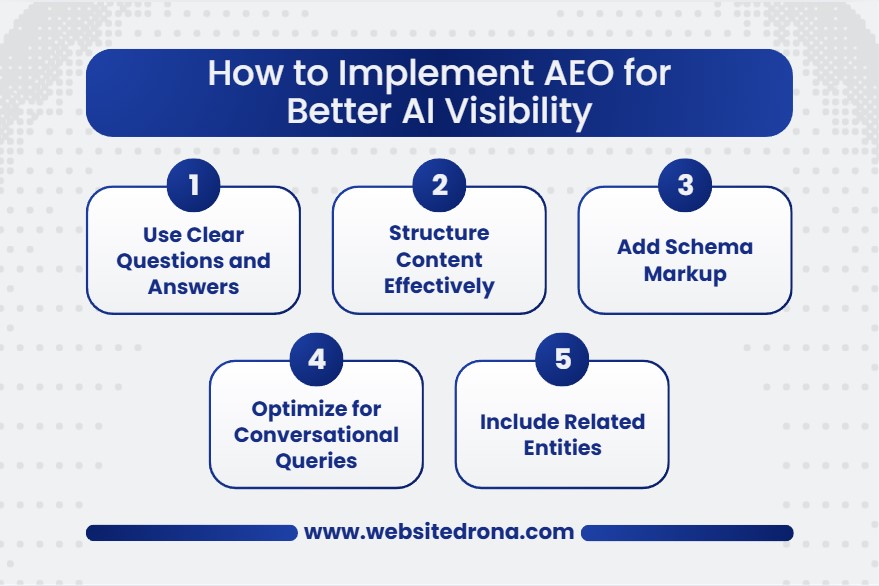
In 2025, search isn’t just about keywords — it’s about answers. With AI tools like ChatGPT, Gemini, and Google’s Search Generative Experience (SGE) changing how people find information, Answer Engine Optimization (AEO) has become the next big shift in digital marketing. If your content doesn’t provide quick, structured, and AI-friendly answers, you’re invisible in the new search era. Unlike traditional SEO, which focuses on ranking web pages through keywords and backlinks, AEO focuses on providing clear, direct answers to user queries—especially for AI-powered search engines, voice assistants, and Google’s featured snippets.
Google introduced the Helpful Content Update in 2022, which rewards websites that deliver real value, provide clear answers, and structure information effectively. The rise of AI-powered search engines between 2023 and 2025 has made AEO an essential ranking and visibility factor. Along with Passage Indexing and the growth of AI-driven search, this makes AEO (Answer Engine Optimization) more critical than ever. After AI started shaping how search results are delivered, optimizing content for direct answers and structured readability is no longer optional—it’s essential for staying visible, credible, and competitive.By implementing AEO strategies, businesses can become trusted authorities, appear in featured snippets, and make their content easily discoverable by both human readers and AI systems. In this blog, we’ll guide you through what AEO is, why it matters, its benefits, and step-by-step methods to implement it effectively in 2025.
What You’ll Learn in This Blog
-
- What Is Answer Engine Optimization (AEO) and Why Does It Matter in 2025?
- AEO vs SEO: The Key Differences Explained
- How to Combine SEO and AEO for Maximum Visibility
- How Answer Engine Optimization Works Behind the Scenes
- Top Benefits of AEO for Businesses in 2025
- Step-by-Step: How to Implement AEO for Better AI Visibility
- Common AEO Mistakes to Avoid
- Tools and Resources for AEO
- Google & AI Updates That Made AEO Essential
- AEO for AI Chatbots & Google SGE
- Frequently Asked Questions (FAQs)
What Is Answer Engine Optimization (AEO) and Why Does It Matter in 2025?

AEO stands for Answer Engine Optimization. It is a modern approach to digital marketing that focuses on optimizing content so search engines, AI tools, and voice assistants can understand and present it as a direct answer.
Unlike traditional SEO, which aims to rank pages for specific keywords, AEO ensures your content is structured, scannable, and ready to provide immediate answers to user questions.
For example, if a user asks, “What is AEO in digital marketing?” a website optimized for AEO can appear directly in Google’s answer box or AI-driven response, giving instant credibility and increasing traffic to your site.Google’s previous updates emphasize helpful content, structured data, and clear answers, which aligns perfectly with AEO strategies. By adopting AEO, businesses can not only improve visibility but also position themselves as trusted authorities in their niche.
AEO vs SEO: The Key Differences Explained
To implement AEO successfully, it’s crucial to understand how it differs from traditional SEO. Here’s a clear comparison:
| Aspect | SEO | AEO |
| Focus | Ranking web pages for keywords | Providing direct, structured answers to queries |
| Goal | Increase organic traffic | Appear in featured snippets, AI responses, and voice search |
| Format | Long-form, keyword-heavy content | Short, scannable, conversational, structured content |
| User Intent | Primarily human readers | Both AI systems and human readers |
| Updates | Keyword and backlink focused | Google helpful content and structured data updates |
As Google evolves with AI, AEO becomes a necessary complement to SEO(Search engine optimization), ensuring your content is discoverable in the increasingly AI-driven search ecosystem.
How to Combine SEO and AEO for Maximum Visibility
While SEO and AEO have different goals, using them together strategically can maximize your content’s visibility in 2025. Here’s how:

1. Use SEO for Discovery, AEO for Direct Answers
-
- SEO helps your content rank for high-volume keywords, bringing users to your site.
-
- AEO ensures that once users arrive—or even before, via AI snippets—your content answers their questions clearly, increasing engagement and credibility.
2. Optimize Content Structure
-
- Apply traditional SEO tactics like keywords, meta tags, and backlinks.
-
- Layer on AEO-friendly structure: headings, subheadings, bullet points, numbered lists, and concise answers.
-
- This makes your content AI-readable and scannable, which improves chances for featured snippets.
3. Use Schema Markup for Both SEO and AEO
-
- SEO benefit: Schema helps search engines understand your content, improving ranking potential.
-
- AEO benefit: FAQ, HowTo, and QAPage schema make it easier for AI assistants and Google’s answer engines to surface your content as direct answers.
4. Write for Humans and AI
-
- SEO often focuses on keywords and backlinks, while AEO prioritizes conversational, helpful answers.
-
- Combining them means writing user-friendly content that satisfies both search algorithms and AI-driven answer engines.
5. Leverage Analytics to Optimize Both
-
- Use tools like Google Analytics, Search Console, and AI-driven SEO platforms to track:
- Organic traffic (SEO)
- Featured snippet and AI answer performance (AEO)
- This data helps you refine your strategy and improve both rankings and answer visibility.
Key Insight: By integrating SEO and AEO, your content can attract more traffic, provide immediate answers, and perform better in AI-powered search, giving your website a competitive advantage in the AI-driven search era.
How Answer Engine Optimization Works Behind the Scenes
Answer Engine Optimization works by structuring your content in a way that makes it easy for AI and search engines to understand. This includes:
-
- Structured Content: Use headings, subheadings, bullet points, and numbered lists to break information into digestible chunks.
- FAQ and HowTo Sections: Answer common questions concisely. Structured FAQ and HowTo schema markup increases the likelihood of appearing in featured snippets.
- Conversational Language: AI-driven search favors content written in a natural, human-friendly tone.
- Semantic SEO: Incorporate related terms, entities, and synonyms to help AI understand context.
For example, a blog answering “What is AEO?” should also explain how it differs from SEO, why it matters for AI search, and how businesses can implement it, all in a structured, easy-to-read format.
Top Benefits of AEO for Businesses in 2025
Optimizing for AEO brings multiple advantages for both marketers and businesses:
-
- Increased Visibility: Appear in Google’s AI-generated answers, featured snippets, and People Also Ask sections.
-
- Better Engagement: Users get instant answers, reducing bounce rates and increasing credibility.
-
- Voice Search Ready: Structured, concise answers are perfect for AI assistants like Google Assistant, Alexa, and Siri.
-
- Future-Proofing: As AI search grows, AEO ensures your content remains relevant and discoverable.
-
- Improved Trust: Content that appears in AI responses is often perceived as authoritative and trustworthy by users.
With these benefits, it’s clear that implementing AEO is not just a trend, but a strategic necessity for 2025 and beyond.
Step-by-Step: How to Implement AEO for Better AI Visibility
Optimizing your website and content for Answer Engine Optimization requires careful planning and execution. Here’s a step-by-step approach:

Step 1 – Use Clear Questions and Answers
-
- Include common questions your audience might ask, like:
-
- What is AEO in digital marketing?
- How does Answer Engine Optimization improve SEO?
-
- Provide concise, accurate answers at the start of each section.
Step 2 – Structure Content Effectively
-
- Use headings, bullet points, and numbered lists to break up text.
-
- Keep paragraphs short (2–3 sentences) to improve readability for both humans and AI.
Step 3 – Add Schema Markup
-
- Use FAQ Schema and HowTo Schema to give Google structured data about your content.
-
- This increases the chances of appearing in featured snippets and AI-generated answers.
Step 4 – Optimize for Conversational Queries
-
- Include natural phrases like “how to implement AEO” or “steps for answer engine optimization.”
-
- Write as if you are answering a real user question, not just targeting keywords.
Step 5 – Include Related Entities
-
- AI search looks for semantic context. Include related entities like:
-
- Google AI
- ChatGPT
- Bing AI
- SEO
- Digital marketing strategies
By following these steps, your content becomes AI-friendly, voice-search ready, and authoritative.
Common AEO Mistakes to Avoid
While implementing AEO, avoid these pitfalls:
-
- Keyword Stuffing: Don’t overuse “AEO” or “answer engine optimization.” Focus on natural, helpful content.
- Ignoring Structured Data: Without FAQ or HowTo schema, AI may not recognize your content for featured answers.
- Long, Unscannable Paragraphs: Users and AI prefer concise answers.
- Outdated Content: Google favors content that’s up-to-date and accurate.
By avoiding these mistakes, you maximize the effectiveness of your AEO strategy.
Tools and Resources for AEO
Several tools can help optimize content for Answer Engine Optimization:
-
- Google Structured Data Testing Tool: Verify your schema markup.
-
- SEMRush / Ahrefs: Find semantic keywords and related entities.
-
- AnswerThePublic / AlsoAsked: Identify trending questions for FAQs.
-
- AI Writing Assistants: Format content for conversational AI readability.
These tools ensure your content is structured, scannable, and ready for AI-powered searches.
Google & AI Updates That Made AEO Essential
Recent updates from Google and AI chatbot platforms reward content that provides direct, helpful answers and clear, structured information:
-
- Passage Ranking (Feb 2021): Google started ranking individual paragraphs, not just full pages. Now, well-structured, answer-focused content can show up as results—even within long articles.
-
- Helpful Content System (Aug 2022, Dec 2022, Sept 2023): Google prioritizes sites with clear, user-first answers and real expertise, not just keyword stuffing or AI–generated fluff.
-
- March 2024 Core Update: Integrated helpful content signals, reducing low–quality results and favoring content with useful, structured answers.
-
- AI Overviews (May 2024): Google launched AI-generated summaries, citing websites that provide the best concise answers. This feature expanded worldwide by 2025, making AEO crucial for visibility.
-
- ChatGPT Search (Oct 2024): OpenAI’s search engine started showing web results with direct citations—websites with AEO-optimized content are now referenced in AI responses.
Why does this matter?
With AI and Google giving priority to well-structured answers, AEO helps your content get picked for featured snippets, voice search, and AI-overview citations. For 2025, being the answer—not just a result—is the key to success.
AEO for AI Chatbots & Google SGE
The search landscape in 2025 is dominated by AI-driven experiences like Google’s Search Generative Experience (SGE), ChatGPT, and Bing Copilot. These tools don’t just list web pages — they generate summarized, conversational answers directly within search results. To ensure your content appears in these AI summaries, Answer Engine Optimization (AEO) plays a crucial role.AEO helps structure your content so it’s easily understood, cited, and retrieved by AI systems. When your blog or landing page includes clear questions, concise answers, and schema markup, AI engines can reference it directly — often displaying your brand as the source in generated responses. For example, if someone asks, “What is AEO in digital marketing?”, well-structured AEO content could be featured in Google SGE’s AI summary or even quoted by ChatGPT when users search for the same topic.
Optimizing for AEO in AI environments means focusing on:
-
- Short, direct answers at the beginning of each section
-
- FAQ and HowTo schema markup for structured data
-
- Natural, conversational tone aligned with how people ask questions
-
- Keeping content accurate, updated, and trustworthy
By aligning your AEO strategy with AI chatbots and Google SGE, you extend your visibility beyond traditional search rankings — positioning your brand as a trusted source of information in the AI-driven search era.
Future of AEO in Digital Marketing
-
- AI-driven search and chatbots will continue growing in importance.
-
- Brands that implement AEO will benefit from higher engagement, visibility, and conversions.
-
- Early adoption provides a competitive edge in search results dominated by AI.
Businesses ignoring AEO may see decreasing organic visibility, as AI prioritizes content that directly answers queries.
Final Thoughts: Why You Should Start AEO Today
Answer Engine Optimization (AEO) is no longer optional; it is an essential part of modern digital marketing. By structuring content, using FAQs and HowTo formats, incorporating schema markup, and optimizing for AI-powered queries, businesses can increase visibility, engagement, and trust.
With Google’s recent updates emphasizing helpful, structured content, implementing AEO now gives you a competitive advantage. Whether you are a small business, startup, or marketing professional, optimizing for AEO ensures your content remains relevant, discoverable, and future-proof.
Take Action Today: Start integrating AEO strategies into your digital marketing plan and make your content ready for the AI-powered search era.
Frequently Asked Questions (FAQs)
What is AEO?
AEO stands for Answer Engine Optimization. It is the practice of structuring content to rank in AI-powered search results, Google’s featured snippets, and voice search.
Why is AEO important for digital marketing?
AEO improves visibility in AI-driven search results, enhances user trust, and prepares your business for the growing influence of AI in search.
How is AEO different from SEO?
SEO focuses on ranking web pages using keywords and backlinks, while AEO focuses on providing direct, structured answers for AI systems and human users.
Can small businesses benefit from AEO?
Absolutely! Even small websites can appear in AI-driven results by providing clear, concise answers to relevant questions.
Can I use SEO and AEO together?
Absolutely. SEO helps users find your content through keywords, while AEO ensures AI systems and voice searches feature your content directly as an answer. Combining both gives you the best of visibility and authority.

Leave a Reply